

My Earth Tube Story. I saw my first “earth tube” back in 2004, on a tour of row houses in Darmstadt, Germany — a tour which had been organized by the Passivhaus Institut (PHI) to show international visitors some examples of Passivhaus construction.

As a visiting Canadian engineer specializing in residential energy efficiency, this was a novel and, for me, unheard-of way to temper incoming ventilation air from extremes of heat and cold. As Dr.Wolfgang Feist, PHI founder and our tour leader that day, explained, “The efficiencies of this approach are extremely high… These earth tubes generally work very well, but they have to be installed correctly or you can have problems.” Condensation and mold Bad news travels fast, and it only takes one “problem” house to undo a lot of good work. During the past ten years in Europe, more than one earth tube was incorrectly installed, leading to pooling of condensate in summer, local mold growth, and major downstream problems with the incoming air quality.
Q. A. Q. A. Q. A. Build-It-Solar Blog: Cristian's Earth Sheltered Passive Solar Home in Romania. Cristian is an engineer in Romania, and has designed, built, and lived in this passive solar, earth sheltered house for two years.
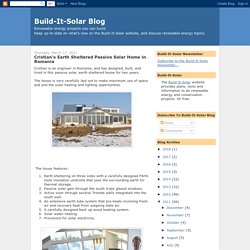
The house is very carefully laid out to make maximum use of space and and the solar heating and lighting opportunities. The house features:Earth sheltering on three sides with a carefully designed PAHS style insulation umbrella that uses the surrounding earth for thermal storage.Passive solar gain through the south triple glazed windows.Active solar through several Trombe walls integrated into the south wall.An extensive earth tube system that pre-heats incoming fresh air and recovers heat from outgoing stale air.A carefully designed back up wood heating system.Solar water heatingProvisions for solar electricity.The house is located at 45 degrees north latitude and has a serious winter -- the total heating bill for the past two winters has been $70 worth of wood -- about 0.6 cords.
What is Geothermal? - Geothermal Resources Council. Home > What is Geothermal?
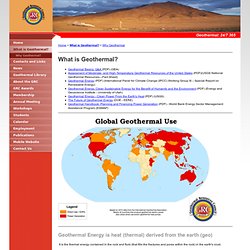
> Why Geothermal Geothermal Energy is heat (thermal) derived from the earth (geo) It is the thermal energy contained in the rock and fluid (that fills the fractures and pores within the rock) in the earth's crust. Calculations show that the earth, originating from a completely molten state, would have cooled and become completely solid many thousands of years ago without an energy input in addition to that of the sun. It is believed that the ultimate source of geothermal energy is radioactive decay occurring deep within the earth (Burkland, 1973). In most areas, this heat reaches the surface in a very diffuse state. The uses to which these resources are applied are also influenced by temperature. Geothermal Power Plants Geothermal power plants use hydrothermal resources that have two common ingredients: water (hydro) and heat (thermal).
There are three basic types of geothermal power plants: PAHS - Umbrella House. Figure 1 Geodome, the first umbrella home (in idealized form), maintains a 66° to 74° temperature year-round without heating equipment in western Montana’s cold climate.
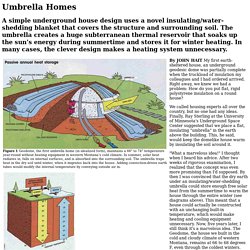
In summer, solar heat radiates in, falls on internal surfaces, and is absorbed into the surrounding soil. The umbrella traps heat in the dry soil until winter, when it migrates back into the house. Adding convection-driven earth tubes would modify the internal temperature by conveying outside air in.
Figure 2 Twenty feet under the surface, the soil temperature reflects the average ambient air temperature during the year. Hybrid Ventilation System - GreenGarageWiki. From GreenGarageWiki return to Living Building Design Studio What is It?
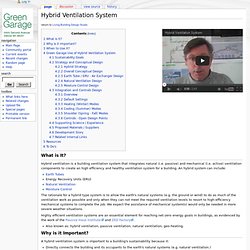
Hybrid ventilation is a building ventilation system that integrates natural (i.e. passive) and mechanical (i.e. active) ventilation components to create an high efficiency and healthy ventilation system for a building. An hybrid system can include: The rationale for a hybrid type system is to allow the earth's natural systems (e.g. the ground or wind) to do as much of the ventilation work as possible and only when they can not meet the required ventilation levels to resort to high-efficiency mechanical systems to complete the job. Highly efficient ventilation systems are an essential element for reaching net-zero energy goals in buildings, as evidenced by the work of the Passive Haus Institute and ZED Factory. Earthtubing for sustainable, passive geothermal heating & cooling. Earthtubes (earthtubing) are a most highly recommended low-tech, sustainable, non-electric, zero-energy, geothermal passive solar heating and solar cooling system.
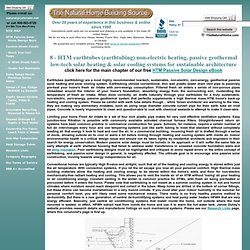
Earthtubing utilizes conventional, thin wall plastic sewer drain vent pipe to passively pre-heat your home's fresh air intake with zero-energy consumption. Filtered fresh air enters a series of non-porous pipes embedded around the interior of your home's foundation, absorbing energy from the surrounding soil, moderating the temperature of fresh air intake. When done correctly, air drafts naturally through your earthtubes for a truly sustainable, non-electric, zero-energy, passive geothermal system that perfectly supplements a high thermal mass HTM home's back-up heating and cooling system.
Please be careful with earth tube details though... while 'Green architects' are warming to the idea, they are making very elementary mistakes, such as using large diameter concrete culvert pipe for their earth tube air inlet pipes. Earth Tube Natural Heating & Cooling. Healthy News and Information.